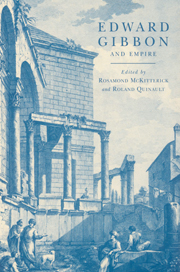Book contents
- Frontmatter
- Contents
- List of contributors
- Preface
- List of abbreviations
- Introduction
- 1 Gibbon and the later Roman Empire: causes and circumstances
- 2 Gibbon and Justinian
- 3 Gibbon and the middle period of the Byzantine Empire
- 4 Byzantine soldiers, missionaries and diplomacy under Gibbon's eyes
- 5 Gibbon and the later Byzantine Empires
- 6 Gibbon and the Merovingians
- 7 Gibbon, Hodgkin, and the invaders of Italy
- 8 Gibbon and the early Middle Ages in eighteenth-century Europe
- 9 Gibbon and the ‘Watchmen of the Holy City’: revision and religion in the Decline and fall
- 10 Gibbon and international relations
- 11 Gibbon's Roman Empire as a universal monarchy: the Decline and fall and the imperial idea in early modern Europe
- 12 The conception of Gibbon's History
- 13 Winston Churchill and Gibbon
- Epilogue
- Index
Introduction
Published online by Cambridge University Press: 02 December 2009
- Frontmatter
- Contents
- List of contributors
- Preface
- List of abbreviations
- Introduction
- 1 Gibbon and the later Roman Empire: causes and circumstances
- 2 Gibbon and Justinian
- 3 Gibbon and the middle period of the Byzantine Empire
- 4 Byzantine soldiers, missionaries and diplomacy under Gibbon's eyes
- 5 Gibbon and the later Byzantine Empires
- 6 Gibbon and the Merovingians
- 7 Gibbon, Hodgkin, and the invaders of Italy
- 8 Gibbon and the early Middle Ages in eighteenth-century Europe
- 9 Gibbon and the ‘Watchmen of the Holy City’: revision and religion in the Decline and fall
- 10 Gibbon and international relations
- 11 Gibbon's Roman Empire as a universal monarchy: the Decline and fall and the imperial idea in early modern Europe
- 12 The conception of Gibbon's History
- 13 Winston Churchill and Gibbon
- Epilogue
- Index
Summary
Why do we, or why should we continue to read Gibbon's History of the decline and fall of the Roman Empire? The many who still read Gibbon – a number surely set to rise further with the publication of David Womersley's new edition of Decline and fall – may do so for reasons which have little to do with Gibbon's subject or his historical method, but more for his superb wit and ruminative literary style and for his reputation as one of the finest of the historians produced by the European Enlightenment. Consequently, the new edition of Decline and fall was at first reviewed by modern rather than by classical or medieval historians. Thus Jose Harris has observed that Gibbon's ability to speak to us now is ‘not a consequence of his scholarship (which was often faulty) nor the authority of his historical judgment (which was often grotesquely biassed) but in the style of his writing, the high drama and human interest of his subject matter, and in the fact that many of the philosophical dilemmas which confront and engage him seem eerily familiar in the present day’. Gibbon remains ‘part of the mental furniture of any reasonably literate person … his reputation has been given a series of shots in the arm by the rise of literary theory, the fashion for Europeanism, and the revival of academic interest in the history of civic humanist thought’.
- Type
- Chapter
- Information
- Edward Gibbon and Empire , pp. 1 - 11Publisher: Cambridge University PressPrint publication year: 1996



